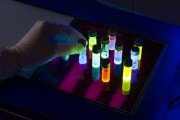 2016-01-15
2016-01-15
Use of copper as a fluorescent material allows for the manufacture of inexpensive and environmentally compatible organic light-emitting diodes (OLEDs). Thermally activated delayed fluorescence (TADF) ensures high light yield. Scientists of Karlsruhe Institute of Technology (KIT), CYNORA, and the University of St. Andrews have now measured the underlying quantum mechanics phenomenon of intersystem crossing in a copper complex. The results of this fundamental work are reported in the Science Advances journal and contribute to enhancing the energy efficiency of OLEDs.
Continue reading →
 2016-01-15
2016-01-15